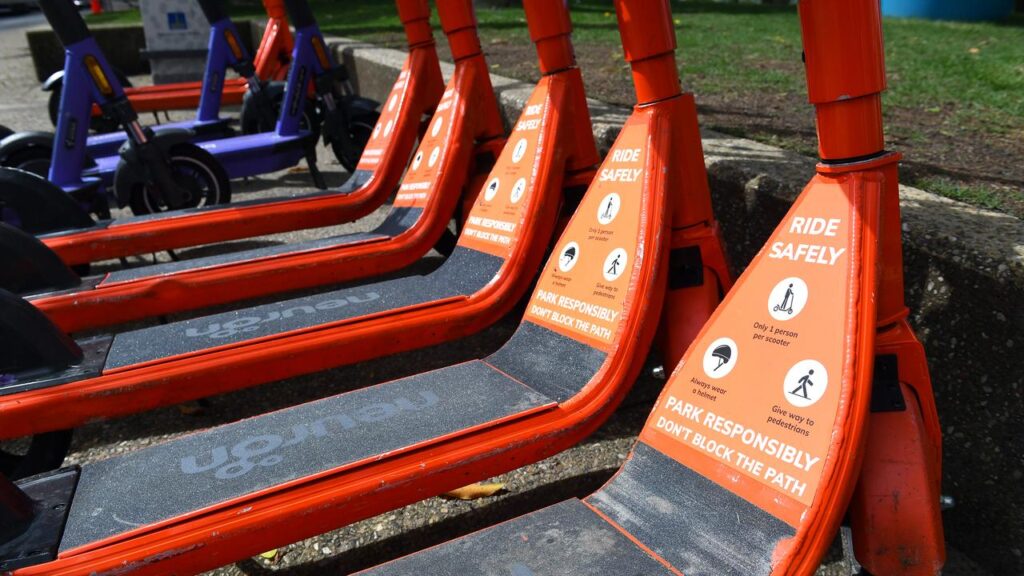The e-scooter menace: mum’s anguish over near tragedy
Savannah Meacham |

After begging his parents for an e-scooter, Gavin wanted to make the most of it after school.
The 11-year-old asked his mum if he could ride around the neighbourhood while his older brother watched.
Gavin was given the thumbs up, so long as he wore a helmet.
His mum, Angela Boldt, left to pick up groceries, thinking he’d be fine.
Then she received the call every parent dreads.
“My 17-year-old son rang and said ‘Gavin’s come off his scooter’,” she recalls.
“I asked if he was alright and he said ‘he’s not moving, he’s bleeding’.”
Her son sent her a photo of Gavin unconscious and prone, a river of blood streaming from his head.

Ms Boldt dropped everything and ran home as Gavin was rushed to Queensland’s Sunshine Coast University Hospital.
The registered nurse met him as he was wheeled in off the ambulance and dozens of staff rushed to help.
“Seeing your 11-year-old get intubated and not be able to support their own breathing functions is a sobering thing,” she says.
Gavin had suffered a skull fracture and brain haematoma. With the possibility a major artery had also been cut, an urgent decision was made to airlift him to Brisbane.
Ms Boldt and her husband sped to the city’s children’s hospital, where they were met outside by a neurosurgeon. It was a bad sign.
The doctors discovered Gavin had almost severed the artery in the back of his head, which was pumping blood into his skull.
The impact of the fall had also forced his brain into a ‘corner’ of his bone framework.
The family was warned that Gavin had just the barest chance of survival, in the realm of one per cent.
“I just dropped to the floor,” Ms Boldt says.

They were encouraged to deliver their boy last messages of hope, which Ms Boldt whispered in his ear.
“I’ll always be with him and I love him, and he’s the centre point of my life,” she recalls saying.
Gavin miraculously survived but a year later, is still recovering after learning to walk, talk, use his hands and feed himself again.
“It’s been a really long, painful journey but full of gratitude,” Ms Boldt says, thanking staff at Nuroflex and Nourish, Flourish and Thrive for their ongoing support.
Gavin’s memories of the accident are restricted to riding down a large hill when the scooter’s handlebars started wobbling before he was catapulted over them.
He hadn’t been wearing a helmet. Instead, it was slung over his handlebars.
He was found 30 metres from where his scooter lay.
Gavin has no desire to ride an e-scooter again. His mother destroyed the one he fell from with her car, determined that it would never again operate.

He’s one of almost 180 kids who suffered e-scooter injuries and attended Sunshine Coast University Hospital in 2023 and 2024.
Research has found the scenario for one in 10 of them was life-threatening.
Most alarming was that nearly half the kids were not wearing a helmet at the time of the accident, despite one being mandatory.
More than a third of the accidents involved speeds greater than the limit of 25km/h and the practice of two kids riding a scooter at the same time, or doubling, was a feature in 12 per cent.
Collisions with cars occurred in 13 per cent of the cases, while eight per cent involved other e-scooters or mobility devices.
Dr Matthew Clanfield was working in the hospital’s paediatric department during the survey period and witnessed kids arriving with injuries every couple of days.
“I was thinking ‘this can’t be right’,” he says.
“The injuries ranged from a simple fall and scraping a knee … to some kids needing to be flown down to Brisbane to receive urgent neurosurgery to save their lives.
“Now, that’s a pretty serious level of injury.”

Dr Clanfield says some kids were lucky to be alive.
“There are that many near misses that I can’t even count,” he says.
“We had one child who hit a car at approximately 70km/h and they survived, luckily, but there are so many kids who aren’t as lucky.”
Queensland’s most recent fatality occurred when an 18-year-old crashed on Flinders Highway near Townsville in the state’s north, on May 31.
The Sunshine State, South Australia and the ACT allow kids aged 12-15 to ride e-scooters if an adult supervises them.
NSW, Victoria, Western Australia and Tasmania users must be over 16 and those in the Northern Territory over 18.
Queensland police are cracking down on illegal use amid a skyrocketing injury rate.
During a recent Gold Coast sting, a 10-year-old boy was spotted on a scooter doing wheelies. His mum told police it was hers and was issued a fine.
The incidents underline the alarming risk kids are taking and are reflected in data showing one in three e-scooter deaths in Australia involve children.

In the past five years, there have been 36 fatalities, 12 of them children.
“It’s a gross over-representation … and it’s indicative of a very clear overexposure to risk,” says University of Melbourne’s Milad Haghani.
“Sometimes the data is fuzzy and not very clear but in this particular case, it is actually quite clear.”
More than half the child fatalities were in Queensland.
Prof Haghani suspects the state’s early uptake of e-scooters and the laws allowing under-16-year-olds to ride the devices are contributing to the deaths.
Researchers say age of use should, as it is elsewhere, be raised to 16 to try to slow the injury rate.
Queensland has established a parliamentary inquiry into e-scooter benefits, safety risks, rules and their enforcement, and stakeholder views.
But as Dr Clanfield says, an inquiry isn’t needed just to raise the age limit.
“Our government really needs to take action now,” he says.
“It doesn’t need to wait for a statewide inquiry to be published to see what other states are doing and do the right thing and make our kids safe.”

Perth has suspended e-scooter hire after a 51-year-old pedestrian was killed in a May 31 collision in the CBD, amid calls for a legislation overhaul.
Ms Boldt is calling for e-scooter speeds to be capped, saying no device should be able to travel 50km/h.
She also wants more support for victim families trying to cope with the physical and emotional trauma.
Dr Clanfield’s research has been published in the Australian and New Zealand Journal of Public Health.
AAP


